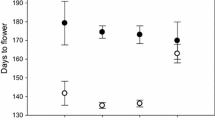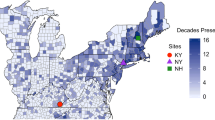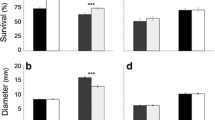Abstract
Over the last two decades, Aegilops triuncialis (barbed goatgrass) has rapidly spread into many annual grassland and serpentine soil sites within California, USA. The capacity of this species to invade edaphically stressful serpentine soil is especially unusual. It is unclear whether genetic differentiation, phenotypic plasticity, or both have allowed A. triuncialis to invade competitive (i.e. high productivity non-serpentine annual grassland) and edaphically stressful (i.e. low productivity serpentine) environments. We used a reciprocal transplant field experiment to examine the effects of plasticity and genetic variation on A. triuncialis phenology and demography along invasion fronts associated with interspecific competition and edaphic gradients. We reciprocally transplanted seeds collected behind invasion fronts (core subpopulations) and along invasion fronts (edge subpopulations). For both gradient types we measured higher reproduction and population growth at invasion front edges. This was true for both edge and core subpopulation seed sources, suggesting that phenotypic plasticity may facilitate invasive spread. Consistent planting site effects indicated that phenotypic plasticity is a primary contributor to A. triuncialis demographic responses along interspecific competition gradients. In contrast, significant seed source effects suggest genetic differentiation along invasion fronts in serpentine edaphic gradients. Although persistent maternal environmental effects cannot be ruled out entirely, seed source effects suggest genetic differences between serpentine subpopulations located behind and beyond the invasion fronts for plant survival, plant size, total seed production, and individual seed size. Rapid expansion of A. triuncialis in California may reflect an evolutionary capacity in this species for both phenotypic plasticity and genetic differentiation.






Similar content being viewed by others
References
Baker HG (1974) The evolution of weeds. Annu Rev Ecol Syst 5:1–14
Baythavong B, Stanton ML, Rice KJ (2009) Understanding the consequences of seed dispersal in a heterogeneous environment. Ecology 90:2118–2128
Bradshaw AD, Hardwick K (1989) Evolution and stress—genotypic and phenotypic components. Biol J Linn Soc 37:137–155
Brady KU, Kruckeberg AR, Bradshaw HD (2005) Evolutionary ecology of plant adaptation to serpentine soils. Annu Rev Ecol Evol Syst 36:243–266
Dietz H, Edwards PJ (2006) Recognition that causal processes change during plant invasion helps explain conflicts in evidence. Ecology 87:1359–1367
Dyer AR, Brown CS, Espeland EK, McKay JK, Meimberg H, Rice KJ (2010) The role of adaptive trans-generational plasticity in biological invasions of plants. Evol Appl 3:179–192
Espeland EK, Rice KJ (2007) Facilitation across stress gradients: the importance of local adaptation. Ecology 88:2404–2409
Eviner VT, Chapin FS (2003) Gopher-plant-fungal interactions affect establishment of an invasive grass. Ecology 84:120–128
Ghalambor CK, McKay JK, Carroll SP, Reznick DN (2007) Adaptive versus non-adaptive phenotypic plasticity and the potential for contemporary adaptation in new environments. Func Ecol 21:394–407
Jain SK (1969) Comparative ecogenetics of two Avena species occurring in central California. Evol Biol 3:73–118
Kennedy PB (1928) Goatgrass or wild wheat (Aegilops triuncialis). J Am Soc Agron 20:1292–1296
Kruckeberg AR (2004) The status of conservation of serpentinite sites in North America. Int Geol Rev 46:857–860
Lee CE (2002) Evolutionary genetics of invasive species. Trends Ecol Evol 17:386–391
Leger EA, Rice KJ (2003) Invasive California poppies (Eschscholzia californica Cham.) grow larger than native individuals under reduced competition. Ecol Lett 6:1–9
Leger EA, Espeland EK, Merrill KR, Meyer SE (2009) Genetic variation and local adaptation at a cheatgrass (Bromus tectorum) invasion edge in western Nevada. Mol Ecol 18:4366–4379
Lyon DJ, Baltensperger DD, Rush IG (1992) Viability, germination, and emergence of cattle-fed jointed goatgrass seed. J Prod Agric 5:282–285
Lyons KG, Shapiro AM, Schwartz MW (2010) Distribution and ecotypic variation of the invasive annual barb goatgrass (Aegilops triuncialis) on serpentine soil. Invasive Plant Sci Manage 3:376–389
Meimberg H, Hammond JL, Jorgensen C, Park TW, Gerlach JD, Rice KJ, McKay JK (2006) Molecular evidence for an extreme genetic bottleneck during the introduction of barbed goatgrass, Aegilops triuncialis, to California. Biol Invasions 8:1355–1366
Meimberg H, Milan NF, Karatassiou M, Espeland EK, McKay JK, Rice KJ (2010) Patterns of introduction and adaptation during the invasion of Aegilops triuncialis (Poaceae) into Californian serpentine soils. Mol Ecol 19:5308–5319
Parker IM, Rodriguez J, Loik ME (2003) An evolutionary approach to understanding the biology of invasions: local adaptation and general-purpose genotypes in the weed Verbascum thapsus. Conserv Biol 17:59–72
Peters A, Johnson DE, George MR (1996) Barb goatgrass: a threat to California rangelands. Rangelands 18:8–10
Rice KJ, Mack RN (1991a) Ecological genetics of Bromus tectorum. II. Intraspecific variation in phenotypic plasticity. Oecologia 88:84–90
Rice KJ, Mack RN (1991b) Ecological genetics of Bromus tectorum. III. The demography of reciprocally sown populations. Oecologia 88:91–101
Richards CL, Bossdorf O, Muth NZ, Gurevitch J, Pigliucci M (2006) Jack of all trades, master of some? On the role of phenotypic plasticity in plant invasions. Ecol Lett 9:981–993
Roach DA, Wulff RD (1987) Maternal effects in plants. Annu Rev Ecol Syst 18:209–235
Sakai AK, Allendorf FW, Holt JS, Lodge DM, Molofsky J, With KA, Baughman S, Cabin RJ, Cohen JE, Ellstrand NC, McCauley DE, O’Neil P, Parker IM, Thompson JN, Weller SG (2001) The population biology of invasive species. Annu Rev Ecol Syst 32:305–332
Sambatti JBM, Rice KR (2006) Local adaptation, patterns of selection, and gene flow in the Californian serpentine sunflower (Helianthus exilis). Evolution 60:696–710
SAS Institute (2011) SAS for Windows version 9.3. SAS Institute Inc., Cary, NC
Sexton JP, McKay JK, Sala A (2002) Plasticity and genetic diversity may allow saltcedar to invade cold climates in North America. Ecol Appl 12:1652–1660
Sexton JP, McIntyre PJ, Angert AL, Rice KJ (2009) Evolution and ecology of species range limits. Annu Rev Ecol Evol Syst 40:415–436
Sultan SE, Bazzaz FA (1993) Phenotypic plasticity in Polygonum persicaria 1. Diversity and uniformity in genotypic norms of reaction to light. Evolution 47:1009–1031
Sultan SE, Barton K, Wilczek AM (2009) Contrasting patterns of transgenerational plasticity in ecologically distinct congeners. Ecology 90:1831–1839
Thomson DM (2007) Do source-sink dynamics promote the spread of an invasive grass into a novel habitat? Ecology 88:3126–3134
Thomson DM, Baythavong BS, Rice KJ (2011) Invasions and the evolution of range limits. In: Harrison S, Rajakaruna N (eds) Serpentine: the evolution and ecology of a model system. University of California Press, Berkeley, pp 201–219
van Slageren MW (1994) Wild wheats: a monograph of Aegilops L. and Ambylopyrum (Jaub. & Spach) (Poaceae). Wageningen Agric Univ Papers 94:37–380
Zohary D, Feldman M (1962) Hybridization between amphidiploids and the evolution of polyploids in the wheat (Aegilops-Triticum). Evolution 16:44–61
Acknowledgments
The authors wish to thank the personnel at the University of California McLaughlin Reserve and the University of California Hopland Research and Extension Center for logistic support. Comments from S. Keller and two anonymous reviewers on earlier versions of the manuscript were very helpful. Special thanks to K. Lyons for generously sharing her expertise on goatgrass invasion ecology and evolution. This research was supported by U.S.D.A. grant ARS-X3 W-3402 to K. Rice and A. Dyer, U.S.D.A. NRI grant 2005–35320–15314 to J. McKay and K. Rice, and Packard Foundation Grant 2000–01607 to K. Rice.
Author information
Authors and Affiliations
Corresponding author
Appendix
Appendix
See Tables 2, 3, 4, 5, 6, 7, 8, and 9.
Rights and permissions
About this article
Cite this article
Rice, K.J., Gerlach, J.D., Dyer, A.R. et al. Evolutionary ecology along invasion fronts of the annual grass Aegilops triuncialis . Biol Invasions 15, 2531–2545 (2013). https://doi.org/10.1007/s10530-013-0471-6
Received:
Accepted:
Published:
Issue Date:
DOI: https://doi.org/10.1007/s10530-013-0471-6




